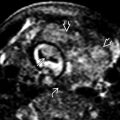KEY FACTS
Terminology
- •
Controversial as to etiology, but simplest concept is entrapment of fetal parts by disrupted amnion
Imaging
- •
Asymmetric distribution of bizarre “slash” defects is hallmark of syndrome
- •
Craniofacial deformities often severe; may look like anencephaly with singe orbit involvement
- •
Abdominal wall defects are large, complex, often with complete evisceration
- •
Extremities often involved
Top Differential Diagnoses
- •
Body stalk anomaly: Fetus stuck to placenta, short cord
- •
Developmental craniofacial and abdominal wall defects have defined anatomic distributions
- ○
Cephaloceles at suture lines (occipital most common)
- ○
Gastroschisis/omphalocele have characteristic appearance
- ○
Clinical Issues
- •
Defects range from minor to lethal
Scanning Tips
- •
Look for bands in any fetus with large abdominal wall or asymmetric craniofacial defect
- •
Amniotic band may be tightly adherent and difficult to see
- ○
Look for restricted movement of involved area
- ○
Changing maternal position may “float” fetus away from uterine wall, revealing short band
- ○
Use high-resolution transducer for detailed assessment in near field
- ○
- •
Edema of extremity distal to constricting band may progress to limb amputation
- ○
Use Doppler to check flow distal to constricting band
- ○
Abnormal, but present blood flow distal to band may identify cases suitable for fetal surgery
- ○
 tethered to each other (pseudosyndactyly) and to the thumb
tethered to each other (pseudosyndactyly) and to the thumb  by a short band
by a short band  , which was best seen on real-time evaluation. Remember to use cine clips and high-resolution transducers for focused assessment of bands.
, which was best seen on real-time evaluation. Remember to use cine clips and high-resolution transducers for focused assessment of bands.
 . As an isolated finding, this would be of little consequence, but, in this case, the only other area involved was the umbilical cord, which was occluded by a band, resulting in intrauterine fetal demise.
. As an isolated finding, this would be of little consequence, but, in this case, the only other area involved was the umbilical cord, which was occluded by a band, resulting in intrauterine fetal demise.
 around the left calf with compromised flow in the posterior tibial artery
around the left calf with compromised flow in the posterior tibial artery  . The anterior tibial artery
. The anterior tibial artery  is unaffected with good flow distal to the constriction. The infant had only extremity involvement and has done well with plastic surgery.
is unaffected with good flow distal to the constriction. The infant had only extremity involvement and has done well with plastic surgery.
 from a constriction band. Another band is seen encircling the forearm
from a constriction band. Another band is seen encircling the forearm  .
.
Stay updated, free articles. Join our Telegram channel

Full access? Get Clinical Tree








